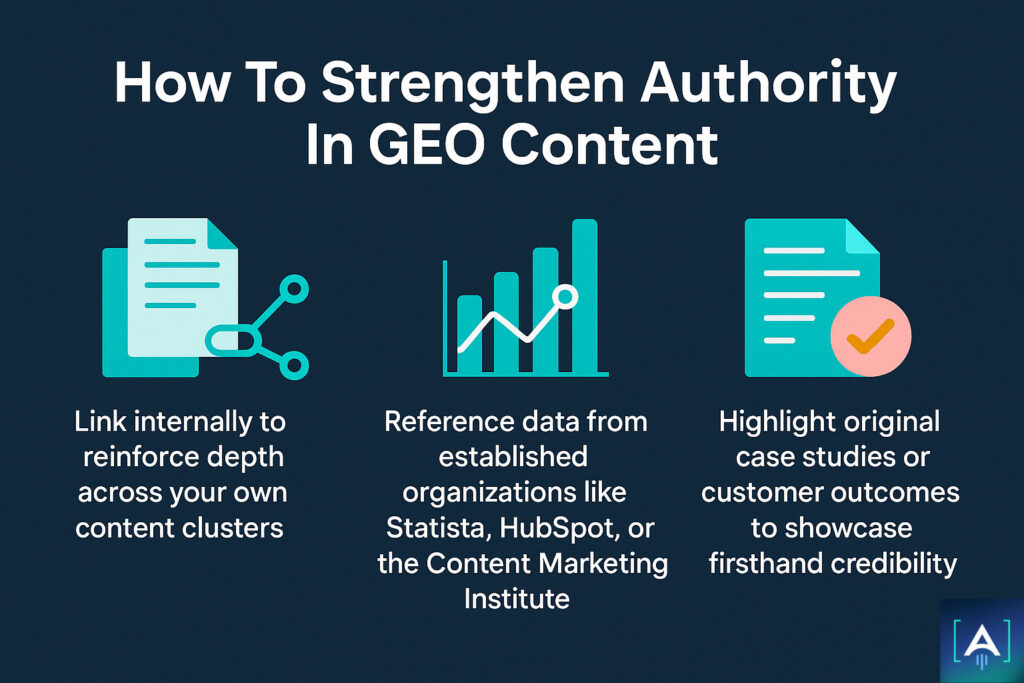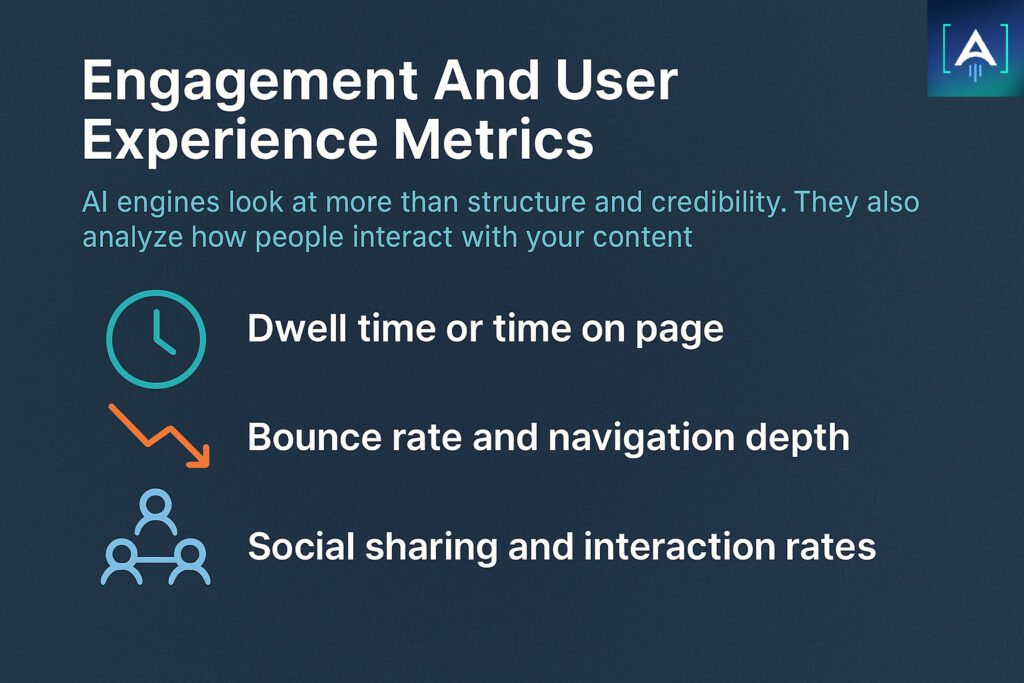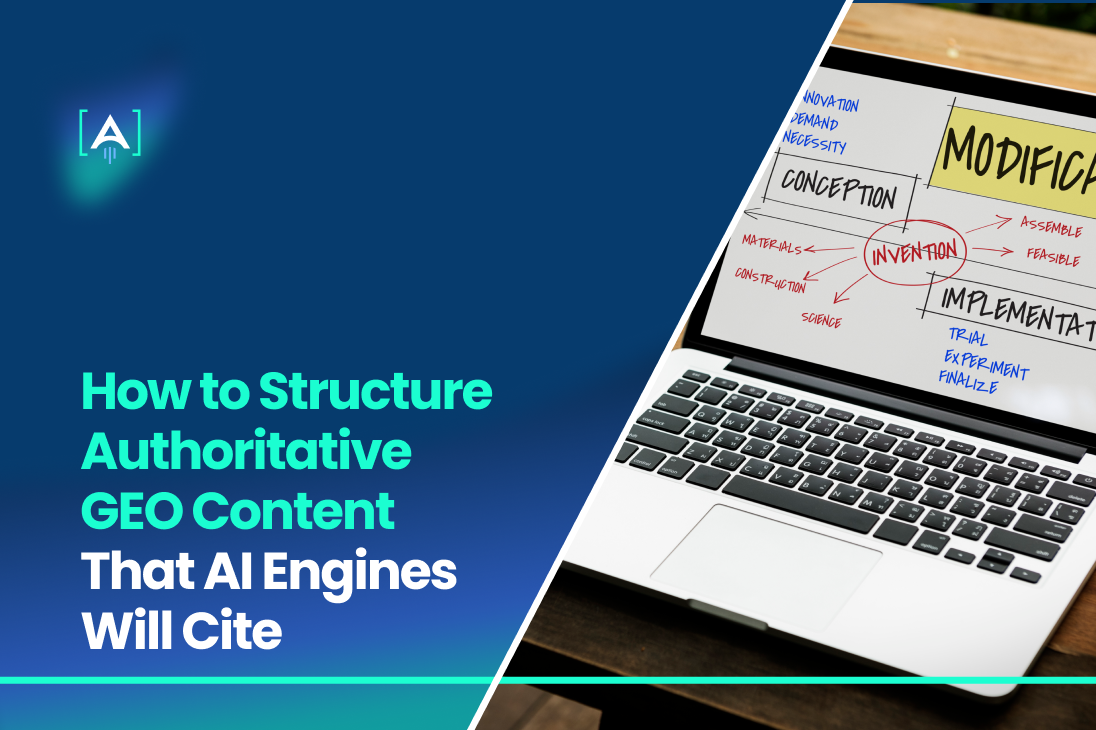GEO content is the foundation of visibility in the age of generative AI.
Unlike traditional SEO, which focuses on ranking in search engine results, GEO content is designed to be selected and cited directly by AI engines like ChatGPT, Claude, or Gemini.
When your business becomes the source these systems reference, you gain an edge in authority, credibility, and market presence.
The stakes are high. Business owners and CEOs who understand how to build content that resonates with AI engines will stay visible to decision-makers. Those who ignore this shift risk losing relevance altogether.
GEO is far more than a passing trend. It provides the framework for building content that AI engines can interpret, validate, and elevate.
While traditional SEO still holds value, the shift from SEO to GEO signals a new era where AI citations define authority.
Partnering with a trusted GEO agency helps businesses navigate this transition with the right strategies and tools to stay visible and credible.
For now, let’s learn more about GEO content.
The Importance of GEO Content
GEO content is designed specifically for generative AI engines. It answers questions directly, presents information clearly, and demonstrates authority in a way machines can easily validate.
Think of it as creating material that speaks two languages at once: it satisfies human readers with clarity and detail while giving AI engines structured signals that confirm accuracy and trustworthiness.
The difference between GEO vs. SEO is more than technical. SEO optimized for ranking positions. GEO optimizes for direct inclusion in AI-generated answers. In practice, that means your brand is not waiting to be clicked. It is already part of the response.
Why does this matter? Because GEO is the new SEO. Whether it is B2B executives researching vendors or e-commerce buyers looking for trusted products, the source cited by an AI carries immense influence. It’s even been statistically recorded that AI impacts businesses worldwide.
Structured Information With AI Schema Markup
AI engines depend on structured information. Without it, even valuable content risks being overlooked.
This is where AI schema markup becomes a cornerstone of GEO content. Schema is the framework that signals what your content is about, helping AI engines categorize and cite it with confidence.
Why Schema Markup Strengthens GEO Content
- Creates a standardized way for AI engines to process your site
- Reduces ambiguity by clarifying context
- Increases visibility in zero-click content where AI surfaces answers directly
Practical Ways To Apply Schema
- Use FAQ schema for common industry questions
- Add product schema to e-commerce pages for credibility
- Include review schema to highlight trust indicators
- Apply article schema to thought leadership content
- Validate markup regularly with Google’s Rich Results Test
Authoritative And Verified Sources
AI engines must minimize risk. That means they elevate content that is verifiable and linked to credible sources.
For your GEO content to earn citations, it must prove authority. That proof comes from weaving internal expertise with references to reliable external research.
How To Strengthen Authority In GEO Content
- Link internally to reinforce depth across your own content clusters
- Reference data from established organizations like Statista, HubSpot, or the Content Marketing Institute
- Highlight original case studies or customer outcomes to showcase firsthand credibility

The result is a double benefit. Your audience sees your brand as transparent and trustworthy, while AI engines interpret those links as signals of reliability.
In e-commerce, for example, a store that cites transparent sourcing data or recognized review platforms is far more likely to be cited by an AI than one that makes unsupported claims.
Relevance And Topical Depth
Relevance is no longer just about keywords. For AI engines, it is about intent. Content that addresses a topic deeply and thoroughly will always outperform shallow material.
Writing for AI means anticipating the exact questions a decision-maker might ask and providing answers that leave no gaps.
Strategies To Increase Relevance And Depth
- Build topic clusters where one core piece connects to multiple supporting articles
- Use zero-click content strategies by answering direct questions clearly in headers and FAQs
- Refresh outdated pages with new statistics and insights
- Create long-form guides supported by visuals, data, and real-world examples
Pro tip: Treat every piece of GEO content as if it were teaching both a machine and a person. AI engines reward content that anticipates multiple layers of a question, not just the surface.
Consistent GEO Workflows And Content Cadence
Consistency is often overlooked, but it is one of the strongest signals AI engines evaluate. Sporadic publishing suggests unreliability, while a steady cadence builds trust.
What Consistency Signals To AI
- Frequent publishing shows your brand is dependable
- A consistent cadence demonstrates authority and staying power
How To Maintain Reliable GEO Workflows
- Develop a quarterly content calendar around GEO priorities
- Use GEO tools to automate publishing and tracking
- Repurpose evergreen assets like webinars into articles, infographics, or guides
- Monitor engagement metrics to refine future content
Engagement And User Experience Metrics
AI engines look at more than structure and credibility. They also analyze how people interact with your content. Engagement metrics prove whether a page delivers value.
Key Engagement Metrics AI Evaluates
- Dwell time or time on page
- Bounce rate and navigation depth
- Social sharing and interaction rates

Optimizing for these signals requires focusing on user experience. Add visuals, infographics, or interactive elements. Break down long sections into easy-to-scan formats. Provide clear CTAs that guide readers further.
Step-By-Step Guide To Structuring GEO Content For AI Citations
Use this playbook to make your pages easy for AI systems to find, understand, trust, and cite. Follow the steps in order. Repeat the workflow for every priority topic.
Pick the question you want to win
- Write the exact user prompt your buyer would ask, in natural language.
- Example: What is server side tracking for ecommerce and how do I implement it on Shopify
- Add constraints that reflect real intent such as team size, budget, timeline.
- Create a prompt basket of 10 to 20 must win questions per product or service.
Choose the best format for that question
- Definition page for “what is” questions
- How to guide for procedures and checklists
- Comparison page for “X vs Y” and “best tools”
- FAQ hub for a cluster of narrow questions
- Data note for a statistic or benchmark you want cited
Outline with answer first blocks
Structure each section so a model can lift a sentence without reading the whole page.
For every H2 section use this pattern
- Direct answer in one sentence
- Three to five bullets with specifics and examples
- Short recap of two lines with the key takeaway
Template
H2: Question in user words
Answer: One clear sentence that resolves the question.
• Specific point 1 with number or example
• Specific point 2 with number or example
• Specific point 3 with number or example
Recap: Two line summary that restates the decision or action.
Write question style headings
- Replace vague headings like “Overview” with real questions
- Examples: How much does it cost, When should you use this, What are the risks
- Use H2 for main questions and H3 for subquestions.
Keep paragraphs self contained
- Two to three sentences per paragraph.
- Repeat key entities by name such as brand, product, feature.
- Avoid long prefaces. Put the answer first, context second.
Add proof the model can verify
- Cite credible sources and include the year.
- Example: According to the Bureau of Labor Statistics 2024 report…
- If it is your own data, add a one line method.
- Example: Based on 1,246 anonymized accounts from Jan to Jun 2025.
Use tables for choices and comparisons
AI loves compact structure for decisions.
Comparison table essentials
- Columns for options
- Rows for attributes such as price, features, limits
- A final row labeled Best for with simple scenarios
Check technical access for AI crawlers
- Allow GPTBot, CCBot, PerplexityBot, Claude Web, and Google Extended in robots.txt.
- Keep important text server rendered or reliably visible after rendering.
- Ensure fast load, clean mobile view, and descriptive image alt text.
Publish in ecosystems models already consult
After your main page goes live, create supporting versions.
- LinkedIn Article with the same answer first sections and a compact table
- YouTube video with a clear transcript
- Authentic answers in one or two relevant Reddit or Quora threads
- Review platforms or industry media where appropriate
These placements are additional evidence that reinforces authority.
Run AI quality checks before and after launch
Before publish
- Ask two or three of your target prompts in ChatGPT browsing, Gemini, and Perplexity.
- Paste your draft into a private test page and see which sentences get lifted.
- Tighten wording where models ignore or misread your points.
After publish
- Re test one week later. Log whether your page is cited and which snippet appears.
- Adjust headings, first sentences, and tables if the wrong content is being lifted.
Track GEO specific metrics
Add these to your dashboard along with classic SEO.
- Citation frequency for your brand and key URLs
- Share of answer across a fixed prompt basket
- Prompt coverage count
- Answer accuracy rate for mentions
- AI referred traffic and branded search uplift
- Time to inclusion from publish to first citation
Tie each metric to a next action. For example, low prompt coverage leads to new FAQ entries or a comparison table. Slow time to inclusion triggers schema and internal linking fixes.
Keep governance tight
- Maintain a single source of truth for product names, pricing, and positioning.
- Review pages and schema quarterly for freshness.
- Create a correction workflow for model mistakes. Update pages with clear, dated facts and distribute a short clarification.
Use the quick build kit for each new page
One page checklist
- Answer first sentence at the top of every section
- Three to five specific bullets per section
- Two line recap per section
- Comparison table where a choice exists
- Five to ten FAQs with concise answers
- Article plus FAQPage or HowTo schema
- Dated citations to credible sources
- Clean headings, short paragraphs, visible entities
- Robots.txt allows AI crawlers, page is fast and mobile friendly
- Distribution plan for LinkedIn, YouTube transcript, and one community reply
Copy blocks you can reuse
- Definition opener: [Term] is [short definition] that helps [audience] achieve [outcome]. It matters when [trigger].
- Pricing opener: Most teams pay [price range] for [solution], which covers [scope]. Costs increase with [drivers].
- Decision recap: Choose [option A] if you need [scenario]. Choose [option B] if you prioritize [scenario].
Need help shipping this at scale
Azarian Growth Agency can turn this workflow into your operating rhythm. We define the prompt basket, restructure high value pages, implement schema, produce comparison and data assets, publish on the surfaces models read, and report citations, share of answer, and accuracy.
If you want your brand included inside AI answers, not only ranked on a page, we can help.
Common GEO Mistakes That Limit AI Citations
Even strong businesses make simple mistakes that limit visibility.
Top GEO Mistakes
- Stuffing content with keywords instead of writing for AI
- Ignoring schema markup and structured frameworks
- Publishing irregularly or inconsistently
- Linking weakly without credible references
- Producing shallow content with no depth or originality
Each mistake creates friction that prevents AI engines from trusting and citing your content. Avoiding them is as important as following best practices.
Measuring Success And Optimizing GEO Content
Success in GEO is measurable. By tracking AI citations, engagement, and brand authority growth, you can continuously improve your strategy.
How To Measure GEO Success
- Use analytics dashboards to monitor AI-driven referral traffic
- Track mentions of your content inside generative engines
- Measure brand authority with visibility and engagement metrics
- Refine workflows based on performance feedback
Forward-thinking businesses already treat their GEO dashboards like they once treated SEO reports. The difference is that now, the focus is not just rankings but direct authority with AI engines.
Conclusion
GEO content is no longer optional. It is the operating strategy that decides which brands get named inside AI answers and which brands disappear.
Leaders who structure content with schema, publish depth with clear answers, prove authority with data and credible bylines, and distribute where models already look earn consistent AI citations and compound brand trust.
For CEOs, this is not a checklist. It is a strategic call about how your company will be discovered in an AI driven market. Act now and you will be cited, trusted, and considered. Wait, and you will be working uphill against competitors who already own the conversation.
At Azarian Growth Agency, we help teams make this shift with hands on training, webinars, playbooks, and working sessions that align content, technical structure, and distribution with the signals AI engines value most.
If you are ready to move from rankings to AI visibility, we will help your brand become the source that gets included in the answer. Let’s talk.

